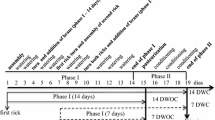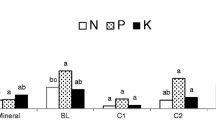Abstract
Three crops of Agaricus bisporus were grown on non-composted substrate (NCS), spent mushroom compost (SMC), a 50/50 mixture of NSC/SMC, or pasteurized Phase II compost. NCS consisted of oak sawdust (28% oven dry wt), millet (29%), rye (8%), peat (8%), ground alfalfa (4%), ground soybean (4%), wheat bran (9%) and CaCO3 (10%). Substrates were non-supplemented or supplemented with Target® (a commercial delayed release nutrient for mushroom culture) or soybean meal at spawning or casing, or with Micromax® (a mixture of nine micronutrients) at spawning. Mushroom yield (27.2 kg/m2) was greatest on a 50/50 mixture of NCS/SMC supplemented with 10% (dry wt) Target® at casing. The same substrate supplemented with Target® at spawning yielded 20.1 kg/m2. By comparison, mushroom yield on Phase II compost supplemented at casing or at spawning with Target® was 21.6 kg/m2 and 20.6 kg/m2, respectively. On NCS amended with 0.74% or 0.9% Micromax® at spawning, yields increased by 51.8% (12.9 kg/m2) and 71.8% (14.6 kg/m2), respectively, over non-amended NCS (8.5 kg/m2). Conversely, mushroom yields were not affected when Micromax® was added to a 50/50 mixture of NCS/SMC. Mushroom solids content was higher in mushrooms harvested from NCS amended with 0.74% Micromax® (9.6%) compared to non-amended NCS (8.3%).
Similar content being viewed by others
References
AMI (American Mushroom Institute) (2005) Spent mushroom compost: Scientific Research and Practical Applications, 23 pp
Bechara MA, Heinemann P, Walker PN, Romaine CP (2005a) Agaricus bisporus grain spawn substrate with S41 and S44 nutrient supplements. ASAE Paper No. 057008. St. Joseph, Mich: ASAE
Bechara MA, Heinemann P, Walker PN, Romaine CP (2005b) Cultivation of Agaricus bisporus on a mixture of cereal grain spawn and delayed-release nutrient supplement. Mushroom News 53(8):6–10
Bechara MA, Heinemann P, Walker PN, Romaine CP, Wilkinson VL (2006a) Evaluating non-composted grain substrates for the production of Agaricus bisporus and Agaricus blazei mushrooms. ASABE Paper No. 067089. St. Joseph, Mich: ASABE
Bechara MA, Heinemann P, Walker PN, Romaine CP (2006b) Non-composted grain-based substrates for mushroom production (Agaricus bisporus). Transactions ASABE 49:819–824
Davis DD, Kuhns LJ (2005) Spent mushroom compost suppresses artillery fungi in landscape mulch. Mushroom News 53(10):11–13
DiSilvestro RA (2001) Flavonoids as antioxidants. In: Wildman REC (ed) Handbook of nutraceuticals and functional foods. CRC Press, Boca Raton, Florida, pp 127–128
Dubost NJ (2006) Evaluation of ergothioneine and other antioxidants in cultivated mushrooms and factors affecting ergothioneine in Agaricus bisporus. Ph.D. Thesis. The Pennsylvania State University
Duns GJ, Rinker DL, King L, Ripley BD, Alm G (2004) Comparisons of odor emissions from mushroom substrate prepared by traditional windrow and forced aeration composting methods using organoleptic and analytical chemical methods of odor assessment. Mushroom News 52(8):6–24
Gerrits JPG (1988) Nutrition and compost. In: van Griensven LJLD (ed) The cultivation of mushrooms. Sussex: Darlington Mushroom Laboratories, Rustington, Sussex, England, pp 29–71
Halliwell B (2001) Free radical reactions in human disease. In: Fuchs J, Packer L (eds) Environmental stressors in health and disease. Marcel Dekker, Inc., 270 Madison Avenue, New York, pp 7–8
Kelsey TW, Singletary L (1997) Conflict at the rural/urban interface: nuisance complaints and mushroom farms in Chester County. Mushroom News 45(5):14–23
Kuehl RO (2000) Design of experiments: statistical principles of research design and analysis, 2nd edn. Duxbury Press. Pacific Grove, CA, 666 pp
Mee HM (1978) Mushroom composting. U. S. Patent No. 4,127,964
Murphy WS (1972) Development of a mushroom production medium without Phase I composting. Mushroom News 20(12):4–22
Noble R, Hobbs PJ, Dobrovin-Pennington A, Misselbrook TH, Mead A (2001) Olfactory response to mushroom composting emissions as a function of chemical concentration. J Environ Qual 30:760–767
Op den Camp HJM, Pol A, van der Drift C, Vogels GD, van Griensven LJD (1991) Odorous sulfur compounds emitted during conventional outdoor- and during indoor-composting. Mushroom Science 13:147–153
Rantcheva T (1972) Composting for mushroom cultivation without using horse manure or any protein-containing additives. Mushroom Science 8:593–600
Reid RJ (2001) Mechanisms of micronutrient uptake in plants. Aust J Plant Physiol 28:659–666
San Antonio JP (1971) A laboratory method to obtain fruit from cased grain spawn of the cultivated mushroom, Agaricus bisporus. Mycologia 63:17–21
Sanchez JE, Royse DJ (2001) Adapting substrate formulas used for shiitake for production of brown Agaricus bisporus. Bioresour Technol 77:65–69
Sanchez JE, Royse DJ, Hernandez G (2002) Development of non-composted substrate for production of Agaricus bisporus. In: Sánchez JE, Huerta G, Montiel E (eds) Proceedings of the 4th international conference on mushroom biology and mushroom products, 20–23 February, Cuernavaca, Mexico, pp 265–270
SAS (2001) Statistical analysis system. SAS Institute Inc., Cary, NC, USA
Schisler LC (1982) New innovations for efficient mushroom growing. In: Wuest PJ, Bengston GD (eds) Penn State handbook for commercial mushroom growers. Special Publication, College of Agricultural Sciences, The Pennsylvania State University, pp 117–118, 129 pp
Schisler LC (1990) Why mushroom production declines with each successive break, and the production of a second crop of Agaricus mushrooms on “spent” compost. Appl Agric Res 5:44–47
Sinden JW, Hauser E (1950) The short method of composting. Mushroom Science 1:52–59
Sinden JW, Hauser E (1954) The nature of the composting process and its relation to short composting. Mushroom Science 2:123–131
Sinden JW, Schisler LC (1962) Nutrient supplementation of mushroom compost at casing. Mushroom Science 5:267–280
Till O (1962) Champignonkultur auf sterilisiertem naehrsubstrat und die wiederverwendung von abgetragenem compost. Mushroom Science 5:127–133
USDA, United States Department of Agriculture (2006) Mushrooms. Agricultural Statistics Board, Washington
Weil DA, (2003) The effect of micronutrients added to compost on yield and quality of fresh mushrooms. M.S. Thesis, The Pennsylvania State University, University Park, PA
Weil DA, Beelman RB, Beyer DM (2004) Effect of adding a micronutrient-rich supplement to compost on yield and quality of Agaricus bisporus. Mushroom Science 16:365–371
Weil DA, Beelman RB, Beyer DM (2006) Manganese and other micronutrient additions to improve yield of Agaricus bisporus. Bioresour Technol 97:1012–1017
Acknowledgments
We appreciate financial support from the Ford Foundation IFP Program to Delphina P. Mamiro during her Ph.D. thesis work at Penn State. We wish to thank Tom Rhodes, Doug Keith, Henry Shawley and Vija Wilkinson for technical assistance.
Author information
Authors and Affiliations
Corresponding author
Rights and permissions
About this article
Cite this article
Mamiro, D.P., Royse, D.J. & Beelman, R.B. Yield, size, and mushroom solids content of Agaricus bisporus produced on non-composted substrate and spent mushroom compost. World J Microbiol Biotechnol 23, 1289–1296 (2007). https://doi.org/10.1007/s11274-007-9364-0
Received:
Accepted:
Published:
Issue Date:
DOI: https://doi.org/10.1007/s11274-007-9364-0




